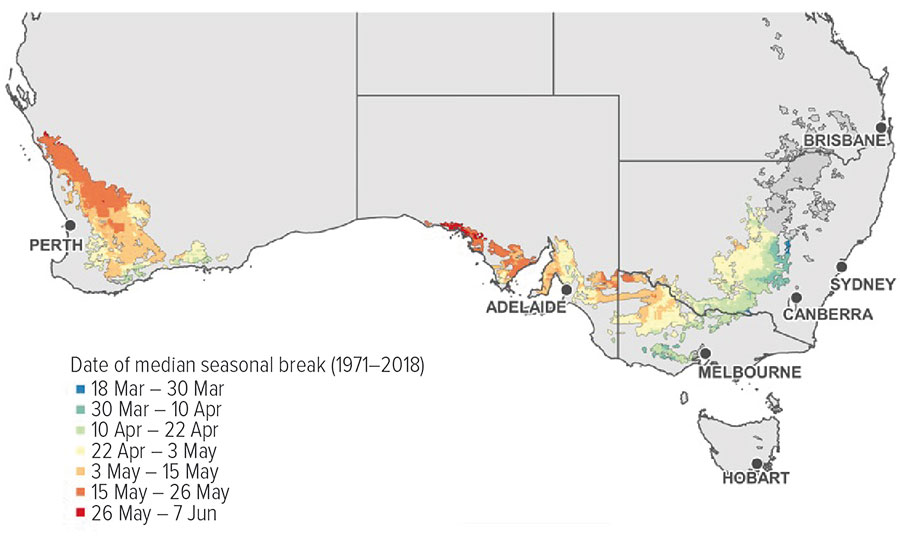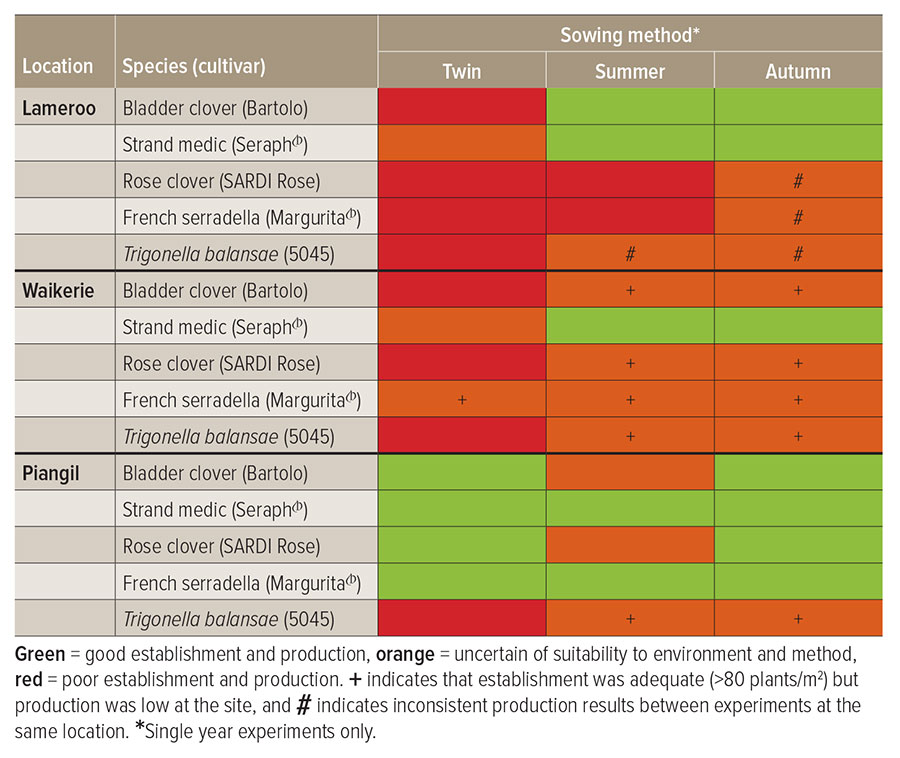A shift towards early sowing, combined with a drying trend in autumn across southern Australia, means growers need adapted varieties and sowing strategies that provide more flexible plant establishment around the seasonal break.
On mixed livestock-cropping farms, where sowing of pastures can clash with cropping programs, and often they are left to the end of the sowing program. Novel pasture establishment techniques include the use of unscarified ‘hard seed’ of adapted pasture varieties, sown either in late summer (summer sowing) or with the previous crop (twin sowing, Figure 1).
Figure 1: Timeline of sowing date (purple), hard-seeded breakdown (grey) and plant growth period (green) of pasture sowing methods tested.
 Source: CSIRO
Source: CSIRO
Novel pasture sowing practices avoid peak crop sowing times, reduce establishment costs and increase early season feed supply for animals. But they have had limited evaluation in low to medium-rainfall environments of South Australia and Victoria until more recently within the Dryland Legume Pasture Systems project.
Seasonal break analysis
The potential for production benefits associated with summer and twin sowing are moderated by the date of the seasonal break.
The seasonal break across the southern Australian was defined as the seven-day period when mean rainfall exceeded evaporation between 1 March and 30 July. This was derived from long-term (1971–2018) climate data for the southern cropping belt.
In environments with a greater probability of an early seasonal break (for example, south-eastern Victoria, NSW), summer sowing will likely be more advantageous as the warm soil conditions support rapid germination and early growth for the autumn feed gap, and an extended growing season can be exploited more often (Figure 2).
Figure 2: Median seasonal break (1971–2018) in cropping regions throughout southern and western Australia based on the seven-day rolling sum of the rainfall to evaporation ratio.

Source: Agricultural Systems 190: 103105
Establishment at Lameroo
Three pasture sowing methods were evaluated in field experiments at Lameroo in the above-average 2020 growing season (457 millimetres, average 381mm) and included legume pasture species traditionally grown in the region – medic (Medicago littoralis cv. Seraph) and vetch (Vicia sativa cv. Studenica), as well as a number of ‘alternative’ legume species. These were Trigonella balansae (acc. 5045), bladder clover (Trifolium spumosum cv. Bartolo), rose clover (Trifolium hirtum cv. SARDI Rose) and French serradella (Ornithopus compressus cv. Margurita). The soil type at Lameroo is sand over loam (zero to 10cm pH in CaCl2 is 7.0).
The sowing methods evaluated were:
- twin sowing (20 May 2019), where ‘hard’ pasture seed/pod was sown with wheat seed in 2019 for 2020 pasture establishment;
- summer sowing (18 February 2020), where hard seed/pod was sown to germinate on the autumn break; and
- autumn sowing (28 April 2020), representing grower practice, where scarified germinable seed was sown on the break of the season.
An early break in the first week of March 2020 enabled early establishment of pasture species from summer sowing. This resulted in higher winter biomass production for summer-sown trigonella and medic compared to autumn-sown. However, summer-sown bladder clover had low plant density and growth compared to the autumn-sown plots.
Rose clover and serradella established adequate plant numbers from autumn sowing, but overall biomass production was low on the neutral pH sand soil. Weed density was greatest in summer-sown (13 weeds per square metre) and twin-sown (eight weeds/m2), compared to autumn-sown (three weeds/m2).
Pasture establishment and production were generally low for all species when twin sowing was implemented, presumably due to furrow in-fill post-seeding resulting in excessive seed burial. Sowing depth needs to be addressed before twin sowing can be recommended for pasture establishment in these environments.
At Lameroo, bladder clover and trigonella production was competitive with medic when sown in autumn and were the best novel pasture options for this site.
The same sowing practices were also evaluated at Waikerie (SA, red alkaline sand 0-10cm pH CaCl2 = 8) and Piangil (Victoria, red loamy sand 0-10cm pH CaCl2 = 7.4) in the 2019 season. Both sites had below-average rainfall with a dry summer and autumn, and all treatments were established within two weeks of each other. Under the dry conditions twin and summer sowing produced no advantage over autumn sowing (Table 1).
Table 1: Summary of novel establishment methods with pasture species at the three sites. Green = good establishment and production, orange = uncertain of suitability to environment and method, red = poor establishment and production.Symbol (+) indicates that establishment was adequate (>80 plants/m2) but production was low at the site, and (#) indicates inconsistent production results between experiments at the same location.

Source: CSIRO
At Waikerie, bladder clover, rose clover, serradella and trigonella established adequately from twin, summer and autumn-sown treatments (more than 80 plants/m2). However, biomass production was significantly less than medic, suggesting that these species were suitable for the novel sowing methods, but were not well-adapted to the Waikerie soil type and environment.
At Piangil, all species established well with twin or summer sowing and had biomass production competitive with autumn-sown medic, except for trigonella, and summer-sown bladder and rose clover. In this environment, summer and twin-sown serradella production was competitive with medic.
Table 1 summarises the performance of the novel pasture legume species under various sowing methods for one year of experiments across three Mallee sites. The performance of species may depend on the environment and the frequency of seasons that offer early establishment opportunities, which are typically infrequent in low rainfall southern environments compared to high-rainfall zones or southern NSW.
This research was part of the national Dryland Legume Pasture Systems project supported by the Australian Government Department of Agriculture, Water and Environment (DAWE) Rural R&D for Profit program and the Grains Research & Development Corporation, Meat & Livestock Australia and Australian Wool Innovation.
More information: Dr Bonnie Flohr, 0475 982 678, bonnie.flohr@csiro.au
Read more: Adaptive sowing strategies to overcome a shifting seasonal break and Agriculture systems 190: 103105

























































